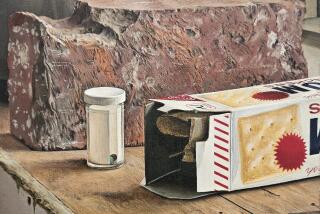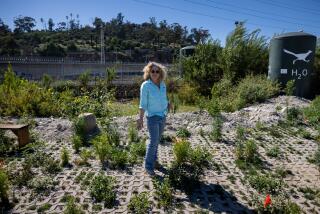As History and Memory Ebb and Flow
âThe Danube Exodus,â an intensely absorbing exhibition, is also a history lesson, a meditation on time and loss, a deep sensory soak and a struggle. What causes the friction is also what generates the most provocative of the showâs unanswered questions, centering on how history is made, processed and understood.
Peter Forgacs created the installation for the Getty Research Institute in collaboration with the Getty and the Labyrinth Project at USCâs Annenberg Center for Communication. Forgacsâ 1997 film of the same name served as the springboard for the show, which examines two journeys along the Danube, one made in 1939 by Eastern European Jews fleeing Nazi forces for Palestine, and the other made in 1940 by Bessarabian Germans being repatriated after Bessarabia (present-day Moldova and part of Ukraine) was occupied by the Soviets. The journeys were in opposite directions, a year apart, but one captain, Nandor Andrasovits, helped ferry the illicit Jewish exodus and the government-sponsored Bessarabian one. With an 8-millimeter movie camera that he used to document life along the Danube, Andrasovits filmed both sets of passengers on their fateful journeys.
The Getty exhibition consists of two basic parts: a film montage using period footage by Andrasovits and others, and a wealth of didactic information in the form of maps, albums, text, diaries and computer stations serving as portals to yet more. The thrust of the Getty Research Institute is represented beautifully by this melding of disciplines.
In the first gallery, a timeline tracks the Jewish exodus from left to right across the wall and a chronology of the Bessarabian German exodus moves from right to left just beneath it. The flow of time and the flow of the river begin to conflate here, in defiance of a single, unified course.
The Danube, which begins in Germanyâs Black Forest and ends in the Black Sea, passes through nearly a dozen countries along its 1,770-mile course. Forgacs situates the river linguistically through a listing of its names in different languages and geographically through numerous hand-drawn maps. Most are the product of an 18th century Bolognese count, who compiled a six-volume encyclopedia on the Danubeâs topography, the everyday life of its fishermen, its flora and fauna, fossils and tides.
Forgacs compares the countâs hunger for knowledge about the river with Andrasovitsâ gathering of data on film, and with his own persistent working and reworking of Danube stories.
This multifaceted introduction to the Danube gives way, in the second part of the exhibition, to an experience of the river based primarily on sensation rather than information. In a darkened room, Forgacs projects footage onto a broad arch of five contiguous screens stretching across one long wall.
A single image occasionally spans all five screens at once. More often, images appear one to a screen, repeating, alternating and mirroring each other to vivid effect. The black-and-white footage is toned blue, gold or rust, and the combinations create an additional dynamic rhythm across the screens.
We see passengers dancing, praying and enjoying the sun, towns along the shore, rolling waves and cloudy skies, all spliced into fragments, slowed to a pensive pace and woven together into a richly textured patchwork of impressions. Tibor Szemzoâs score is haunting in its mix of solemn music, foghorns, bells, the beat of marching soldiers, the occasional voice and the rush of water.
For all of the clean linearity and continuity of the showâs didactic section, the film component is luxuriously discontinuous and provocatively incomplete. Itâs made even more overtly nonlinear by the ability of visitors to choose the order of segments by touch-screen.
Joined in the exhibition, then, are two vastly different modes of organizing meaning--through specific data such as dates, maps and names, and through a more vague network of images, triggered memories and sensory response.
Neither component of the show, alone, would suffice. Together, they make an uneasy pair, but their friction is productive. Itâs the very struggle of forces that ensues in the writing and understanding of history. What we know rubs up against what we sense or intuit; what we can comfortably grasp chafes against what consistently eludes us; what holds true in words challenges what we glean from experience.
The words of Heraclitus appear on a gallery wall and throughout the installation are brought home: âEverything is in constant flux and movement ... nothing is abiding ... Therefore, we cannot step twice into the same river. When I step into the river for the second time, neither I nor the river is the same.â
As a metaphor for historical narrative, the river serves well. Fluid and alive, it continuously changes over time, as different questions are asked and different people do the asking. Questions, rather than answers, are at the heart of that river, that process.
Forgacsâ installation abounds in them. What, for instance, motivated Andrasovits to work the river both ways, to aid passengers on both sides of a political divide? And what was the status of Bessarabian Germans who werenât among the 93,000 transported back to Germany--those, for example, who couldnât provide the solid Aryan credentials required? We know what befell Eastern European Jews not lucky enough to be among the roughly 1,000 to catch a ride down the Danube to survival.
Among the questions that hover, stickily, over this show, is whether the parallel that Forgacs poses between the sets of passengers is true, fair, instructive. Itâs a troubling one, because it disrupts easy assumptions of German guilt. Although the men transported back to Germany from Bessarabia were conscripted into the German military to fight for the Third Reich, at the time of their Danube exodus, they were not perpetrators but victims, uprooted and forced to give up nearly everything they had.
Forgacs brings together the stories of the two journeys and leaves them, side by side as well as visually intertwined, allowing us to draw our own conclusions. His methods are viscerally compelling. The installation immerses us in sound and imagery of tremendous emotional resonance, sweeping us along in its powerful current. Where it delivers us is another, individual matter.
*
âTHE DANUBE EXODUS: THE RIPPLING CURRENTS OF THE RIVER,â Getty Research Institute, 1200 Getty Center Drive, L.A. Dates: Through Sept. 29. Tuesdays-Thursdays and Sundays, 10 a.m.-6 p.m.; Fridays-Saturdays, 10 a.m.-9 p.m. Admission: Free, but parking reservations, $5 a car, are required on weekdays before4 p.m. Phone: (310) 440-7300.
*
Leah Ollman is a regular contributor to Calendar.
More to Read
The biggest entertainment stories
Get our big stories about Hollywood, film, television, music, arts, culture and more right in your inbox as soon as they publish.
You may occasionally receive promotional content from the Los Angeles Times.










